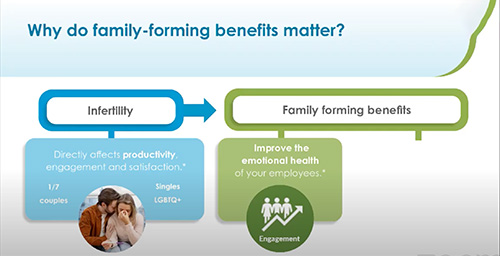Everyone deserves the family they want, but not everyone can form that family on their own. Infertility is a serious problem that recent studies have shown 1 in 6 couples will experience. In these cases,prospective parents need fertility care. Unfortunately, fertility care can be a complicated and expensive process, leaving many who look into it lost and unable to proceed because needed treatment is not affordable. This is where family-forming benefits come into play. These benefits can greatly help employees who are going through fertility care.
Understanding the Significance of Family-Forming Benefits
Offering fertility care can have a significant impact on the workplace since the psychological and emotional impact of dealing with infertility is severe. It leads to a host of other issues, such as depression, anxiety, stress, guilt, and more, which in turn affects the workplace. When employees are suffering from such issues, they are not able to perform so productivity goes down. Making fertility benefits available to employees can prevent this from happening by providing easy access to medical care for infertility.
Employee satisfaction can also be traced to infertility issues. Workers who are unhappy with the benefits available to them will be unhappy in the workplace. Someone struggling with infertility who has limited access to fertility care will not be satisfied with benefits that do not offer such care. Low employee satisfaction leads to a decrease in productivity and a larger likelihood of employees leaving their jobs. Since approximately 70% of employees say they would change jobs for family-forming benefits, keeping them happy is a priority.
Family-forming benefits also have an impact on inclusion and diversity in the workplace. The LGBTQ+ community has often been excluded from access to fertility care, as have singles who would like to raise a child. Also, BIPOC women are less likely to seek fertility care than white women, mainly due to the cost of treatment. LGBTQ+ people, aspiring single parents, and women of color will be drawn to workplaces offering strong fertility benefits, creating a more diverse and productive workplace.
Choosing Fertility Benefits
Benefits managers and company leaders can struggle to choose the right fertility benefits package for their employees. Currently, 40% of employers offer a fertility benefits package, a 10% increase from 2020. These offerings are becoming more popular and employers getting in on this expansion need to know how to find the ideal benefits package that provides the best experience for employees and employers while remaining affordable.
The Best Value for the Best Cost
It is important to get the highest value out of the benefits offered, for both employees and employers. But when value can vary greatly from person to person and from situation to situation, how does an employer know they are truly getting the best value? Value can be defined as quality divided by cost, so a higher cost will lower the value. It is a common misconception that the cost of providing family-forming benefits is high. However, 97% of employers say that adding infertility coverage did not significantly increase the cost of their overall health plans. Therefore, the right plan can make the cost very affordable. However, high value is also dependent on high quality which involves the employee and employer experience and clinical outcomes.
The Employee Experience
Fertility care is a complex process. Many factors come into play for those on the family-building journey. Employees need to receive the highest quality experience they can. The benefits package needs to be properly designed.
Some factors to consider when looking at the employee experience:
- Easy access to fertility treatment: The healthcare system is complicated so employees should be able to easily access the proper services.
- Customizability: Fertility treatment is not one-size-fits-all. Everyone’s situation is different, and the program should be flexible, inclusive and able to meet each employee’s needs.
- Employee navigation with hybrid communications and services: A comprehensive digital platform with resources that connect employees with health care providers, AI-enabled chat, infographics and FAQs go a long way when integrated with in-person one-on-one personal navigation and support.
- Resources and education: Infertility is a complicated topic with which many people are unfamiliar. The right fact-based information needs to be readily available.
- Mental health and emotional support: Access to mental health professionals and guides to navigate the emotional aspects of fertility care are required. Fertility care has a very big mental side to it in addition to physical health. Employees will need access to resources and support groups to help manage their journey.
The Employer Experience
A successful program will not only provide the employee with the best medical care. The process needs to suit the employer’s needs as well.
Some factors to consider when looking at the employer experience:
- Flexibility: The program needs to cater to different companies. Size, location, culture and company goals need to be taken into consideration.
- Easy implementation: A hassle-free onboarding process makes it easier for the employer to sort out.
- End-to-end coverage: The benefits need to cover the entire process, from preconception through fertility treatment, pregnancy, post-pregnancy and back to work.
- Transparency: Employers should know exactly what they are getting and how they are paying for it.
Making It Affordable
Affordability is a major factor that employers consider when choosing a benefits package. There are many ways to lower the cost of family-forming benefits. Fertility treatments can be a long process with many steps so bundled treatment packages are a great way to provide affordable fertility care. Bundles or packages could include services like consultations, diagnostics, medications, and procedures such as in vitrofertilization (IVF), egg or embryo freezing, donor sperm, egg or embryos, surrogacy or adoption. Streamlining the process into evidence-based packages that meets each employee’s unique need brings down the cost.
Getting the Right Treatment
Providing the right fertility benefit ensures the correct treatment for each employee and avoids wasted money for employers. When no such benefits are offered, there is a major problem with employees using their general medical health benefits to pay for what is often improper care. Women often will go to their benefit-covered gynecologist instead of a fertility expert, leading to treatment that is not appropriate for the situation but gets miscoded in the general medical plan so it is covered. When family-forming benefits are offered, employees will receive the proper care they need.
When improper treatment is received but still covered by health benefits, the employer ends up spending money that is often wasted. Employees are more likely to end up incurring extra costs through multiple pregnancies or going through treatment that is not successful at all. The goal is to reduce maternity and NICU costs using high quality care. Family-forming benefits enable employees to seek effective and appropriate treatments.
A Flexible Process
One of the best ways to achieve high value for the employer is create equity through flexible benefits. To have equity for all employees, everyone needing help to form their families has equitable access to benefits that cover every path to parenthood with fertility care and adoption.
There will need to be many treatment options for employees. Individualized treatment packages are a must to make sure everyone gets the appropriate care. The fertility treatment process varies so the treatment packages need to provide access to many different needs along the way. The process may include many steps such as:
- Home testing
- Male testing and treatment
- Trying with ovulation induction (OI) and intrauterine insemination (IUI)
- IVF
- Surrogacy or adoption
- Egg freezing
- Pregnancy navigation and support
- Childcare resources and education
- Assistance returning to work after pregnancy
To provide appropriate care, the benefits need to offer validated treatments. Unfortunately, many unproven treatments can be offered to patients (often called “add-ons”), resulting in expensive yet unsuccessful fertility care. High value benefits should provide access to innovative treatments, but these treatments need to be proven, validated, and most of all, provided in an ethical way based on each patient’s need.
ARC Fertility Is Here to Help
Choosing a family-forming benefits package can be a difficult process, but it doesn’t have to be. ARC Fertility has been providing outstanding service to consumers since 1997. The ARC Fertility Employer Program now makes family-forming benefits easy by partnering with employers to provide flexible and affordable high quality fertility benefit packages. These bundled, evidence-based packages provide employees with access to ARC’s network of top-tier clinics and state-of-the-art treatment, leading to the best outcomes and attracting top talent to the workplace.
Find out more about Family-Forming Benefits
Add Value for Companies, Quality for Employees | Day One & ARC Fertility



